How To Drain Water From Orca Cooler With Garden Hose

Many companies have spent an incredible amount of money and time to convince people that they need to spend ridiculous sums to keep a drink cold. It's not true. Coolers aren't complicated, which is a good thing to remember in the face of all that advertising. After many years evaluating more than 40 models of coolers, we've chosen eight that are well made, well insulated, and fitting for a range of outings.
Best hard cooler: Coleman 70 Quart Coastal Xtreme Series Marine Cooler

Our pick
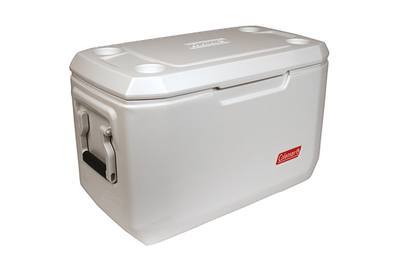
Get this if: You want a cooler for weekends away, car-camping trips, or tailgating, or to keep as a backup cooler in your garage in case your power suddenly goes out. It's a workhorse.
Why it's great: The Coleman 70 Quart Coastal Xtreme Series Marine Cooler is a tremendous value if you're looking for a spacious, reliable cooler. Not only that, it's sized so that you can still move and carry it with reasonable ease. It fits in most cars' trunks and works great as extra seating—it can support up to 250 pounds. The Coleman Xtreme weighs 13.4 pounds empty; filled with 60 pounds of ice, it's still manageable to carry for a short distance. If that weight or size seems intimidating, Coleman makes a similar model with wheels.
In our testing, the Coleman kept ice frozen for a full week (170 hours), which was 30 hours longer than the Igloo MaxCold (140 hours). It measures 28.4 by 15.8 by 17.5 inches tall, its design incorporates bevels and angles all over the place, and it has a ruler and cup holders molded into its lid. Insulation obsessives may want to fill those cup holders with Styrofoam, but given how well this cooler performed in our tests, doing so doesn't seem to be all that critical. The most noticeable functional difference in the designs of the coolers we tested was in their drainage ports. Given that we were draining these coolers upwards of three times a day for several days straight, we learned quite a bit about what works and what doesn't. Unlike most of the others, the Coleman Xtreme has a channeled drain, which made draining much easier and required very little tilting.
Both the Coleman Xtreme and the Igloo MaxCold feature replaceable hardware. (Some of these brands' cheaper models don't.) This is an important detail because the first thing that's going to wear out on a cooler is either a hinge or a handle, and having affordable replacements means a cheap repair rather than a brand-new purchase. At the moment, you can buy Coleman's replacement hinges and handles for less than $10 each and Igloo's parts kit (including hinges and a drain spout) for around $17.
Flaws but not dealbreakers: Coleman makes many nearly identical versions of the Xtreme cooler. We don't know why they all have such similar names and such different looks, but according to sources within Coleman, for practical purposes they are all identical where it counts: in insulation and build materials. We consider all of these models to be part of the same line.
Dimensions: 28.4 by 15.8 by 17.5 inches (LWH)
Also consider: Igloo MaxCold 70

Also great
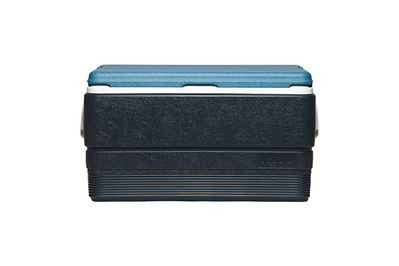
Igloo MaxCold 70
Best for boaters
Six-day ice retention means the Igloo MaxCold does its primary job very well, but the Coleman Xtreme does it a bit better. You can, however, screw a garden hose into the Igloo's drainage port, which makes this cooler good for boaters.
Get this if: You spend a lot of time out on the water.
Why it's great: The Igloo MaxCold 70 Cooler is a solid runner-up to the Coleman Xtreme. It is similar in size and functionality, keeping ice frozen for six days, a day beyond its rated capacity. But the Coleman Xtreme gave seven days of ice in our tests, and its drain port is easier to use and more effective than the Igloo's—unless, that is, you're using it on a boat. The Igloo's drainage port does accept a garden hose, which means you can channel the wastewater far away from the cooler (for instance, over the side of your vessel). So if you'll mostly be using your cooler while afloat, the Igloo MaxCold would be a good option.
The Igloo MaxCold comes in at 29.5 inches long by 16.5 inches wide by 16 inches high and has a simple, utilitarian design that is devoid of any markings or indentations. It weighs about 12 pounds empty and can also be used as a seat. Similar to the Coleman, if the size or weight is intimidating, Igloo makes a slightly smaller model of the MaxCold with wheels. Also like Coleman, Igloo sells replacement parts but in the form of a parts kit that includes hinges and a drain spout.
Flaws but not dealbreakers: Unlike the Coleman Xtreme, the Igloo MaxCold lacks a channeled bilge drain, which makes emptying wastewater a bit more difficult than it needs to be—you have to tilt and twist the cooler to drain the last bit of water.
Dimensions: 29.5 by 16.5 by 15.88 inches (LWH)
For long, tough trips: RTIC 65

Our pick
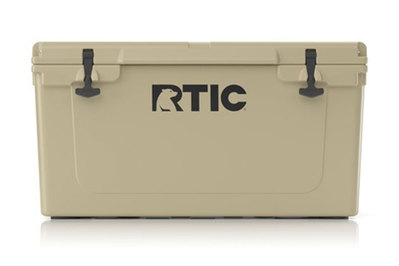
RTIC 65
Tough as nails and inches of insulation
This roto-molded cooler costs far less than the Yeti Tundra 65 but performs just as well in every way. It's almost indestructible; it has two drainage ports and replaceable parts; and it kept our ice frozen for 10 days.
Buying Options
Get this if: You need a cooler that's all but indestructible for longer camping or hunting trips, and you don't mind giving up a bit of interior space for thicker insulation.
Why it's great: Most roto-molded coolers are two or three times more expensive than they need to be. Of all the models we tested—which included the wildly popular Yeti Tundra 65—the RTIC 65 is the best for the price and performance. It's just as tough as any of its competitors and keeps ice from melting for just as long. That said, most people do not need a roto-molded cooler. They're big. They're heavy. They carry less than other coolers the same size because of the amount of insulation they're packed with. In short, they're impractical for most pedestrian needs—a fact that has stopped absolutely none of us from buying them in record numbers.
The RTIC weighs 36.5 pounds and measures 32 by 17 by 18 inches on the outside. It has enough space to hold 65 cans or 70 pounds of ice. Unlike several other competitors, the RTIC has two drainage ports for quick cleaning and draining. Similar to any true roto-molded cooler—the term refers to a manufacturing process that creates uniform plastic walls with no seals—the RTIC is practically indestructible, which makes it great for tougher outdoor environments. In our testing, the RTIC kept ice frozen for 10 days, with some periodic draining.

RTIC has rope handles with a plastic tube for gripping and two rubber latches for holding the lid closed, which mimics the design of most of the other comparable coolers out there.
Flaws but not dealbreakers: Gear Lab pointed out that the rubber latches are the one weak point of the RTIC: "The sheer stretchiness of the rubber latches on the RTIC gives us concern for their durability and longevity. Though we yanked on everything, including the flexible rubber latches, we couldn't get them to break, which gives us hope. We do worry that they may stretch a bit during regular use, becoming looser over time." This isn't wrong. The rubber hinge is somewhat smaller than those on other roto-molded coolers, such as the Yeti. However, we've used the RTIC 65 in Hawaii for two years now as our go-to grocery carrier and haven't had any problems with the rubber components. As a grocery hauler, it's perfect for the task. The thick insulation easily withstands the heat of the sun, even if we leave the car parked for a day.
Dimensions: 32 by 17 by 18 inches (LWH)
Best soft cooler: Polar Bear 24-Pack Nylon Cooler

Our pick
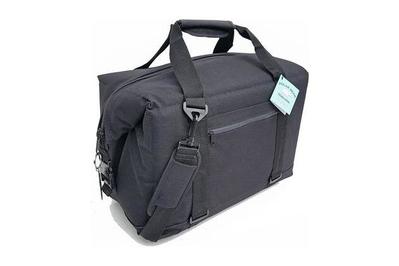
Get this if: You need a cooler for picnics, concerts, or days out to the beach. The soft shape is easier and lighter to carry on your shoulder over slightly longer distances than you might want with a hard cooler. Also, many sport venues and arenas prohibit hard coolers but allow soft coolers like these.
Why it's great: The Polar Bear 24-Pack Nylon Cooler is the best soft cooler we've tested at the price. Made with open-cell insulation, the walls of the Polar Bear are a little denser and a quarter inch thicker than those of most similar soft coolers we tested. Its stitching is a little cleaner, and the 1,000-denier nylon fabric feels slightly more durable, both on its liner side and on its bottom surface. It even sits up a bit better when empty, which lends it a handsome air. The little details add up. That said, over a 24-hour period, the Polar Bear and the AO Cooler are nearly identical in their ability to keep 9 pounds of ice frozen for a day.
The cooler's best design feature is one you will also find in AO Coolers and StrongBags models: When it's open, the bag stands erect like a grocery bag, which provides easy access for loading and unloading. Closed, the top of the bag zips across the middle with two YKK #8 zippers (YKK is the largest, and often considered the most reliable, zipper manufacturer in the world) and folds down on either side, compressing the bag into a rectangular brick. This shape allows for all sides of the bag to have equal insulation coverage when closed—a feature many cheaper soft coolers lack.
The 0.7 mm thermoplastic polyurethane liner on the Polar Bear feels reassuringly sturdy in hand. However, we have read on boating forums reports of Polar Bear coolers springing leaks due to broken bottles or sharp edges on crushed aluminum cans (tip: don't put that stuff in there). That liner can't be replaced, so it's important that Polar Bear has a decent warranty. In interviews, Polar Bear reps explained that if you accidentally puncture the liner in the first two years, the company will replace the cooler for $10 to $15, depending on its size. After two years, the company will give you the option of replacing the cooler for 50 percent of the retail price.
The Polar Bear also held the most cans of any 24-pack cooler we tested. When I pack coolers, I prefer to use a haphazard method, throwing my cans and ice together as quickly as I can. For me, the Polar Bear Nylon swallowed 24 cans and just under 6 pounds of ice with surprising ease. (The AO Cooler, packed in the same casual way, held just 20 cans plus ice.) With careful can stacking, it's possible that intrepid packers might figure out a way to get the Polar to hold even more. While we think the 24-pack size is the most versatile size, some people might prefer the 6-Pack or 12-Pack sizes for more personal uses, like carrying your lunch to a jobsite.
Flaws but not dealbreakers: Fully loaded, the Polar Bear weighs 24 to 26 pounds. It's not impossible to carry around, but like all soft coolers loaded with cans and ice, it's not exactly fun to carry around either. The larger issue is not how heavy it gets but how ridiculously small the shoulder strap and its pad are. Of all our models, the Polar Bear has the smallest shoulder pad by a significant margin. While it was okay enough to carry the bag a short distance, we found that after a while, the small pad would slip off our shoulders, making it pretty useless. Considering the incredible amount of thought that goes into the details of the Polar Bear coolers, the small size of the shoulder strap and pad feels like a surprising oversight.
Dimensions: 18 by 10 by 12 inches (LWH)
Capacity: 24 12-ounce cans
Also consider: AO Coolers Canvas Series 24-Pack Soft Cooler

Also great
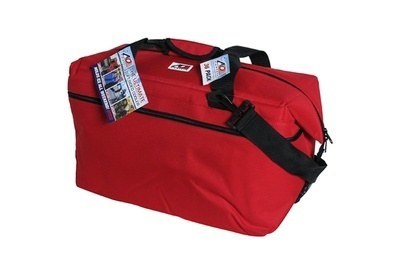
Get this if: You can't find the Polar Bear in stock.
The AO Canvas Series Cooler insulated as well as the best coolers in the test: I loaded every cooler with 9 pounds of ice over a 24-hour period outdoors, exposing them to direct midday sun, and this one left us with 8 cups of meltwater, which was better than any other soft cooler in this price range.
The insulation itself is a 0.75-inch layer of foam. Exactly what kind of foam is difficult to say. On several videos and in conversations with us, AO Coolers has claimed that it uses closed-cell foam in its products. But the feel of the foam insulation, which is spongy and pliable, gives it away as open-cell. Cutting it open confirmed that belief.
Flaws but not dealbreakers: Soft coolers are measured by the amount of cans they can hold, but that isn't really an exact unit of volume. With the AO, we weren't entirely satisfied by its size, especially compared with the other 24-pack models in the test. While you can fit 24 cans in it with some ice, it does fill up more quickly than our other soft cooler pick. If you're stuffing cans and plenty of loose ice into the bag without taking a lot of time to pack precisely—as you might at a beach party or on a boat trip—this is, more realistically, going to hold only 20 cans or so: a little less than the Polar Bear.
Dimensions: 17 by 9.5 by 12 inches (LWH)
Capacity: 20 to 24 12-ounce cans
Best backpack cooler: Polar Bear Original Backpack Cooler

Our pick
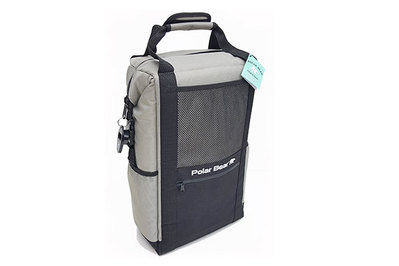
Get this if: Your favorite picnicking spots or beaches tend to be farther off the beaten path or you often find yourself with your hands full of other gear. The backpack is easy enough to carry on your shoulder while you take care of more important things.
Why it's great: Most soft cooler backpacks have issues: They're either uncomfortable to carry when fully loaded with drinks and 20 pounds of ice or aren't particularly good at keeping things insulated. Even the $200 or $300 models have problems. For all our testing, nothing performed as well as consistently as the Polar Bear Original Backpack Cooler. During our testing, it kept things cold for longer than many models two or three times as expensive and was just as comfortable, if not more comfortable, to carry.

For the most part, the Original Backpack Cooler performs nearly identically to the Polar Bear 24-Pack Nylon Cooler. It's made of similar materials, including the YKK zippers—though its exterior is an 840-denier UV-resistant nylon instead of the 1,000-denier nylon—however, the deluxe uses closed-cell foam rather than the Original's open-cell, but both models performed more or less equally over the same 24-hour period during our testing. Each cooler will do exactly what you need it to do, which is to keep things cold for the day while you focus on the fun at hand. However, if you like the more structured feel of closed-cell foam, especially as a backpack, you may prefer the Deluxe model. But we're not sure that small distinction is worth twice the price.
We've tested Polar Bear coolers for five years now, buying or receiving models from Polar Bear itself, and I am consistently surprised by the level of quality control that goes into the company's products. The little details add up, from the quality of the liners to the control of the stitching. This is unusual to see, particularly in larger companies, which can and should control for such things. I'm not saying a Polar Bear will last a lifetime, but if you treat it well it should last a lot longer than you'd expect.
Flaws but not dealbreakers: Although this backpack cooler was as comfortable as any we tested, very few backpack coolers are actually all that comfortable. A cooler like the Original Backpack Cooler is useful for carrying your food and drink for a medium distance when your hands are full with other things, like a beach umbrella, or a coconut, or the hand of your young child. But you wouldn't want to go on a long hike with it or any of the models we tested.
Dimensions: 18 by 12 by 7 inches (LWD)
A burlier backpack option: OtterBox Trooper LT 30 Cooler

Our pick
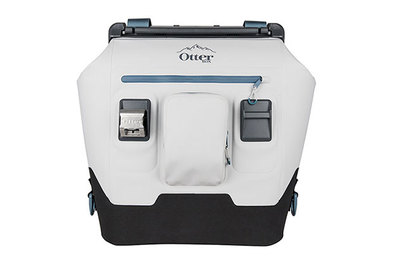
OtterBox Trooper LT 30 Cooler
Heavy-duty backpack cooler
If you need a wide-mouthed cooler that can keep things cold for more than a day, this is your pick. That said, it's heavy and difficult to carry when fully loaded, and we aren't sure how long the complicated lid will stand up to long-term testing.
Get this if: You need the best insulation available in a cooler that can also be carried on your back. The wide mouth is great for large groups or loading awkwardly shaped items you need to keep cool, such as grilling supplies.
Why it's great: The OtterBox Trooper LT 30 Cooler is the most expensive cooler on this list. It costs more than our roto-molded pick despite being half the size and not nearly as indestructible. However, this may hurt less if I also tell you that it is the best heavy-duty soft cooler we've come across so far.

The design completely encloses your ice load with a closed-cell insulation foam that means everything inside the OtterBox will remain cold for well over two or three days if you take care of where you place the bag and don't open it too much. We particularly liked the wide-mouthed design, which—unlike many competitors, such as the Yeti Hopper—was easy to load with ice and even easier to access with a group of friends or family.

Is it a perfect backpack cooler? Not by a long shot. The bag weighs nearly 7 pounds empty. Its materials—closed-cell insulation and TPU-coated nylon—are not light. And the large shape, like that of a huge beach tote, does nothing to keep the weight close to your back. I had to lean pretty far forward just to find a comfortable balance. For reference, I'm 6-foot-3 and weigh 220 pounds, and I did not want to carry this bag any farther than I had to.

However, once you're on the beach or at your campsite, it's a great cooler to have around. It's more versatile than a hard cooler, even if it can't keep the contents as cold for as long, and it's much better insulated than most other soft coolers on the market.
Flaws but not dealbreakers: Apart from that high price, the only thing that worries us—and we simply don't have enough long-term testing to know one way or the other—is how long the lid hinge will last. It appears to be an overly complicated design, with multiple fold points and several interconnected hinges. The OtterBox is protected by a lifetime warranty, so if the hinge does wear out from normal use, you should be covered—not that this will help you if you're off in the middle of the woods at the time.
Dimensions: 21 by 17 by 11 inches (LWD)
Best "disposable" cooler: Igloo Recool

Our pick

Igloo Recool
A disposable composting cooler
Skip the Styrofoam next time you need a disposable cooler. The compostable paper pulp of the Recool composts easily in the backyard, and it performs basically as well as any cheap single-use cooler.
Buying Options
$8* from Target
*At the time of publishing, the price was $10 .
Get this if: You're in a situation where you need a cooler for a short amount of time. Ideally you'll have a longer-lasting reusable cooler on hand, but as the Igloo Recool becomes more common, there should be no reason to reach for a Styrofoam model again.
Why it's great: A disposable cooler is always a backup option, but there are times when it's nearly unavoidable, such as when you're caught out at a picnic or having a lucky day fishing, for instance. The Recool lives up to the hype: It's as effective as a Styrofoam cooler and reusable a few times, and it composts easily in your backyard. The Recool's wood-pulp material (similar to papier-mâché), bound with a biodegradable wax called alkyl ketene dimer, doesn't dissolve when wet. We tested the Recool and a number of cheap, comparably sized foam competitors, filling them up with ice (both types held roughly 16 quarts) and waiting, measuring the accumulated meltwater over time. The Recool promises to keep ice frozen for up to 12 hours, but we found in our testing that it's more like six or eight depending on how much food or drink you want to keep cold, a result similar to what we saw in our testing of Styrofoam equivalents. As for the testing units themselves, well, they've disappeared now. More dirt for my garden.
Flaws but not dealbreakers: We don't recommend getting any disposable cooler if you can buy a halfway decent hard or soft cooler (such as any of the models above). A hard cooler like our top pick can keep ice frozen for a full week. Of course, it's not quite a fair comparison. But even our soft-cooler picks provide almost double the insulation time of the Recool, up to 12 hours (from six).
Dimensions: 15 by 11 by 11.38 inches (LWD)
How we picked

A cooler is made to keep things cold. It does this via insulation. With better insulation, a cooler can maintain lower temperatures for longer, thus consuming less ice. That's important, especially if you, like most people, don't have a freezer that can produce enough ice to fill a cooler and you tend to resort to buying bags of ice from the grocery store or liquor store. Those bags aren't expensive, but if you can use less ice or reload less often, you'll save money in the long run and also spare yourself the hassle of having to leave midparty for more ice or draining your cooler every few hours.
When it comes to hard coolers, today's market is dominated by two names: Igloo and Coleman. Rubbermaid, a former heavyweight, no longer produces the same diversity or quality of coolers it used to. In our research, nearly everyone recommended either an Igloo or Coleman within this price range, and whenever Rubbermaid was mentioned it was most often in the form of a criticism.
For soft coolers, using criteria that guided our previous testing, along with user comments on Amazon and in forums, we narrowed the search by looking for a short list of essential features. We considered the external hardware, shoulder straps, buckles, zippers, and fabric, all of which had to be comfortable to carry and sturdy enough to survive regular use in a boat, on an ATV, or sliding around in the trunk of a car. For backpack coolers, we also specifically looked for reports of how comfortable (or not) they were to wear. And naturally, I focused very closely on every model's level of insulation during testing.
How coolers work and how we tested them
Let's talk about heat, insulation, and polyurethane foam for a minute. Heat, remember, can be transferred in three ways: conduction, convection, and radiation. Conduction is the transfer of heat through a solid (like when a spoon becomes hot after sitting in soup), convection is the transfer of heat through a fluid (including air), and radiation is the emission of electromagnetic energy (like sunlight).

Different types of insulation work in their own ways to minimize heat transfer into a cooler. Open- and closed-cell foams act as insulators to reduce heat conduction, while fabrics and liners, such as coated polyurethane and reflective Mylar, create a radiant barrier that reduces and reflects heat radiation. Everyone wants to claim that they use closed-cell foam in their coolers. And you'll have to trust us that, after hours of research, we have found there's a lot of gray area in what is advertised as closed-cell foam and what actually is. If you're wondering what kind of foam your cooler has, a good rule of thumb is to try and squeeze the foam together with your fingers. If your fingers can compress the foam more than 75 percent, then you're probably dealing with open-cell foam. If the foam feels denser than that and can't be compressed very much at all, you've probably got your hands wrapped around closed-cell foam.

Closed-cell foam is considered a better insulator than open-cell foam because the tiny bubbles of gas in closed-cell foam are independent from one another. Air bubbles that do not share cell walls, in effect being insulated from one another, are better at reducing the overall transfer of heat through the foam. Closed-cell foam is also much more expensive to produce than open-cell foam. The resulting product is strong, very rigid feeling, and typically weighs more than 1.7 pound per cubic foot with greater than 90 percent of its air cells closed to one another. Closed-cell foam is also water-impermeable—making it an ideal material for surfers' wetsuits.
In contrast, open-cell foam is permeable to air and water like a sponge (which is why it is used in foam pillows, as it's squishier and it breathes). But open-cell's ability to insulate is greatly diminished when it's wet, since water permeates all of the open space and acts as a conductor of heat. In open-cell foam, most bubbles (greater than 50 percent) share walls with one another. These foams, which weigh around 0.5 pound per cubic foot, are light and easy to compress.

According to our testing, over a long enough period of time, closed-cell foam will keep things cool for longer. But in the 24- to 48-hour range, there doesn't seem to be a huge difference between using three-quarters of an inch of closed- or open-cell foam in a cooler. Except for cost, of course.
Over the years as we've published and updated this article, and the articles it's based on, we've stuck by two testing methods: measuring meltwater over time to illustrate the relative performance of insulation between coolers and measuring temperature change over time to determine the total length of time that ice stays preserved in a cooler.
By measuring meltwater, we can produce data that illustrates the relative performance of insulation between coolers over time. For example, after five days, the Coleman Xtreme retained 11 more pounds of ice than the Igloo MaxCold. That translates to the Coleman Xtreme being 20 percent more efficient than the Igloo MaxCold overall in ice retention during the same time period. We also started tracking the internal temperature of the bags just to see exactly when temperatures began to rise with the ThermoWorks Signals.
Previously, we've tested hard coolers in the summer in Baltimore, Maryland, through a week that saw highs of 80 to 90 degrees Fahrenheit and lows of 64 to 72 degrees. We tested the soft coolers and backpacks in Ventura, California, by loading every soft cooler with 9 pounds of pre-bagged ice and left them outside for 24 hours, from noon to noon, over two sunny days with an ambient temperature between 70 and 75 degrees with nearly constant sun exposure. And more recently we tested most of our picks again throughout the year in Hawaii.
What size cooler do you need?
Everybody has different needs, and we couldn't test every single size of cooler on the market. Instead, we decided to focus on the most utilitarian and family-friendly sizes we could find. (The exception is backpack coolers, which often come in only one size.)
For hard coolers, a 70-quart size is big enough for a variety of tasks. If you're a boater, as Carolyn Shearlock of The Boat Galley explained, "A 65- or 70-quart cooler is about the minimum size needed to have enough ice and space for food for a weeklong trip for two." Again, this is going to depend on how you pack your cooler and how long you need to keep things cold (more ice will take up more volume). Another example came up last year during a power outage, as one of our staff members was able to store most of the contents of a fridge in a 70-quart cooler, along with the necessary ice to keep it cold.
For soft coolers, we recommend anything in the 20- to 24-can range. That's enough to hold plenty of ice, drinks, and food for a family of three. Anything smaller and you end up carrying a lot of bag without carrying much of anything else. There just isn't enough room to make them functional for anything except an individual lunch or a few drinks.
The competition
Soft coolers
Polar Bear Eclipse 24 Pack: The Eclipse had the same design as Polar Bear's previous models but represented an improvement in nearly every component material. It was an excellent cooler, but even for half the price of the Yeti Hopper, the Eclipse was still too expensive for us to recommend for most people, and it didn't insulate for that much longer than the Nylon. (It has since been discontinued.)
StrongBags Glacier Flight Crew Luggage Cooler: StrongBags manufactures bags specifically for pilots and flight crews. These are decent bags, but they're overpriced compared with the top competition. This model has the same folded origami structure of the Polar Bear Nylon and the AO, but it seems to use a less dense open-cell foam, which hindered its overall performance. Unless you need a soft cooler specifically sized for overhead compartments, as this one is, you can save yourself a bit of money and buy a bag that keeps things cool longer. (Another StrongBags cooler we tested, the Canadian Ice Flight Crew Cooler, has been discontinued.)
Coleman 30 Can Cooler with Removable Liner: The Coleman comes with a removable hard-plastic liner meant to keep your food from being squashed. Still, the cooler itself had thin insulation that just didn't perform as well as that of the Polar Bear Nylon; for half the price, you're sacrificing more than half the performance. This model produced 5.5 cups more meltwater in 24 hours than the Polar Bear did during testing. (One other Coleman cooler we tested had the same flaws as this one.)
Transworld Durable Deluxe: The Transworld Durable Deluxe is neither durable nor deluxe. Its insulation was the thinnest we came across—in 24 hours the 9 pounds of ice we loaded in it was completely melted. It was the only soft cooler we tested that had this happen. Additionally, the hardware on this cooler wasn't built to give anyone confidence. You get what you pay for, and with the Transworld Durable Deluxe you aren't paying for much.
Yeti Hopper Flip: The Hopper Flip is a good soft cooler pick. Like all Yeti soft cooler products, it uses the more expensive closed cell insulation. But we just didn't see that it made much of a difference. Most of the designs are too small for there to be much of a comparable change in performance between open- and closed-cell insulation.
Yeti Hopper Two 30: This tote-style design was a mess. In an attempt to make the closed-cell foam manageable and still more or less able to seal around the ice, Yeti put the zipper on the side of the bag. It was a nightmare to open and a nightmare to access: It bit and scraped our hands every time we tried to pull a beer from its hungry maw. Yeti redesigned the cooler, renaming it the M30 and giving it a magnet closure, but it still costs $300.
Backpack coolers
Icemule Boss: The Boss has solid closed-cell insulation and a deep interior space for ice storage. However, it's more backpack than most people need, unless you're on a serious expedition. If you're an avid fisher or if you need a large backpack with plenty of extra storage and side pockets, this is a good pick.
Icemule Urbano: The Urbano looks better than it performs. Icemule coolers (except for the Boss, above) tend to use pliable open-cell foam, which works fine but isn't as good an insulator as the foam in our other picks. If you like the way this cooler looks and you need a cooler only for light use, such as on day trips, this is a decent pick, but we think our top-pick cooler will serve you better.
Icemule Coolers 15 Liter: This open-cell insulated cooler has an interesting design, similar to that of a stuff sack you might use on camping. It's really designed for the sporty crowd, for paddleboarding specifically, as it's apparently capable of floating even when fully loaded. It performed fairly well in our tests, although its light, open-cell foam insulation hindered it some. If you're looking for a good soft cooler for paddleboarding or to stuff in the back of a kayak—that is, a cooler that also floats and will keep contents cold for a little less than a day—and don't want to spend more than $70, this is a good cooler for you.
Yeti Hopper BackFlip: For the price, Yeti was outperformed by several other similar models, including our top pick among backpack coolers.
Roto-molded coolers
Pelican Elite: The plastic handles on the Pelican Elite 45Q that we tested let down this roto-molded design. Plus, it was just ugly to look at. Pelican has since redesigned its coolers, but the 50Q version costs $300 and the 45Q wheeled version costs nearly $400, so we passed on testing them.
Bison 75 QT: Bison makes a solid cooler for hunters and fishers. This roto-molded design is as good as any we tested, but the RTIC is just as good—and a good deal cheaper.
Esky: Coleman's short-lived entry into the high-end cooler world was a little flat. It cut too many corners, and its unusual shape didn't lend itself to sitting snugly in boats or vehicles.
Canyon: These coolers are close to the RTIC in price, but they use plastic hinges to keep the lid shut and seem to skimp on a few manufacturing details. The rope handles, for instance, are strangely installed in a pass-through loop and don't seem as durable as other models we tested.
Yeti Tundra 65: If you already know you want the name, then buy the name. Yeti makes a good product. It's more expensive than it needs to be or maybe even should be. But it's also the brand that everyone recognizes and many people covet. If that's important to you, at least you know it's also well-made.
About your guide

Kit Dillon is a senior staff writer at Wirecutter. He was previously an app developer, oil derrick inspector, public-radio archivist, and sandwich shop owner. He has written for Popular Science, The Awl, and the New York Observer, among others. When called on, he can still make a mean sandwich.
How To Drain Water From Orca Cooler With Garden Hose
Source: https://www.nytimes.com/wirecutter/reviews/the-best-hard-cooler/
Posted by: worrellhavoing69.blogspot.com

0 Response to "How To Drain Water From Orca Cooler With Garden Hose"
Post a Comment